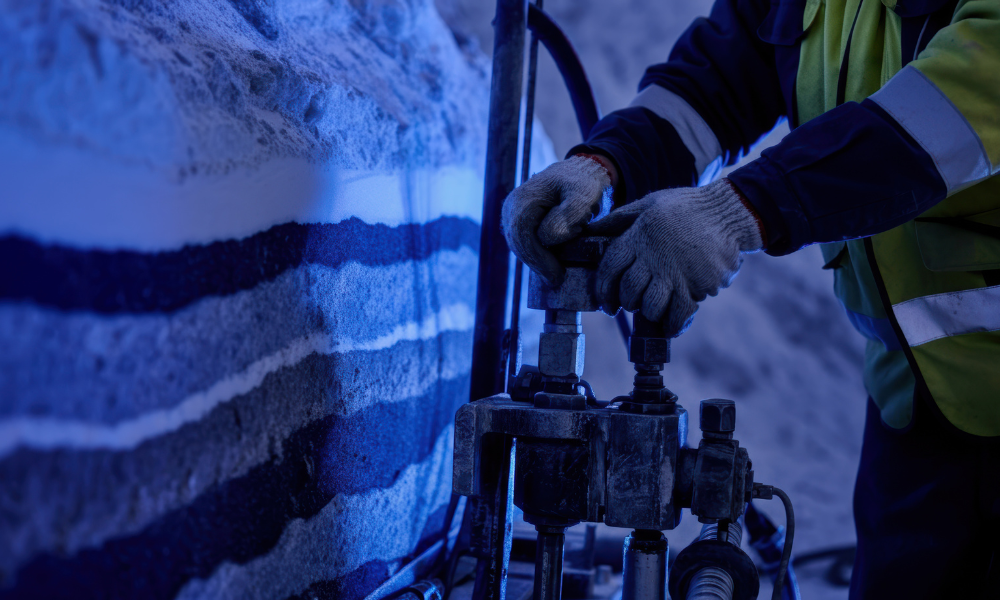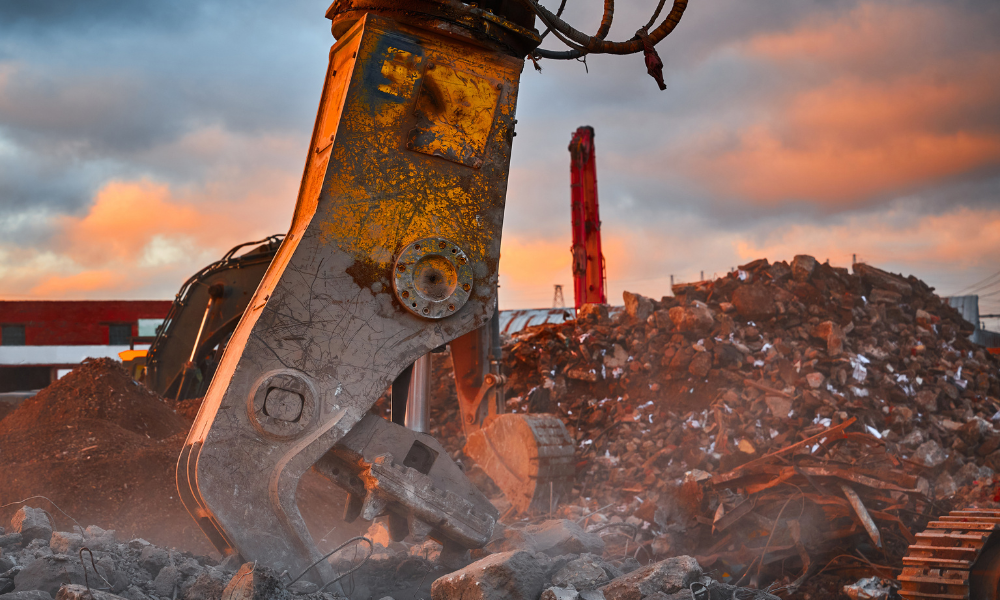Explore the importance of high visibility clothing in Canadian worksites. Learn compliance standards, industry applications, and how it enhances workplace safety
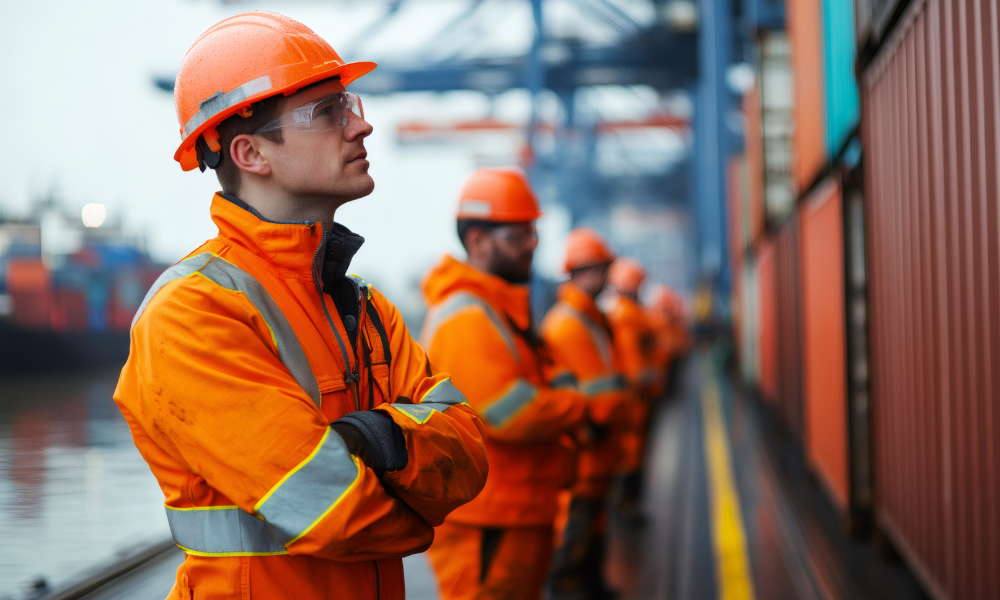
Those who work in high-traffic areas like busy streets, highways, or construction sites must be clearly visible to truck drivers and heavy equipment operators. The risk of these workers getting hit by fast-moving vehicles is high enough to require wearing high-visibility safety apparel or HVSA.
In fact, workers are required by law to wear these bright-coloured safety clothing to mitigate the risk of injury, especially when their work environment has low visibility. Workers who need high-visibility clothing include construction workers, utility workers, roadworkers, and transportation workers.
Their safety at the workplace partially depends on being clearly seen by drivers and heavy equipment operators.
Canadian Occupational Safety discusses the importance of high visibility safety apparel in this guide. We’ll tackle important topics like the benefits of high visibility clothing, offer tips on choosing the right hi-vis clothing, and more.
What are the best high-visibility safety clothing you can get?
The best kinds of clothing you can get are those that are compliant with the safety regulations of in jurisdiction and applicable national standards. Note that high-visibility clothing can come in a variety of shapes, sizes, and designs. These safety garments are available as hooded jackets, vests, harnesses, overalls, and more.
These models also differ in terms of whether they’re made for men or women – an important consideration to ensure an optimum combination of comfort and fit.
Depending on factors like the level of risk and lighting conditions in your workplace, one model may be more suitable for your needs than another. Here are a few examples of some of the best hi-vis safety garments you can provide:
1. CX2 Titan Men’s Hi-Vis Cotton Canvas Vest with Sherpa Lining
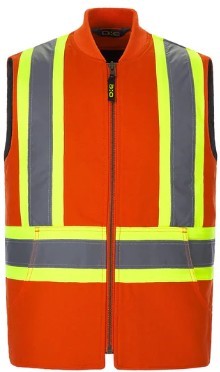
Features:
- Material thickness of 330 gsm – 9.7 oz./yd2 – 16.5 oz./lin. yd
- 100% cotton canvas with water-repellent finish
- Rib knit collar and side seam inserts
- Lined with polyester sherpa fleece
- Kangaroo pouch pockets
- Interior chest pocket
- 4” hi-vis contrast band with 2” reflective tape on front and back body
- Complies with CSA standards
2. Ground Force Hi-Vis Deluxe Surveyor’s Vest
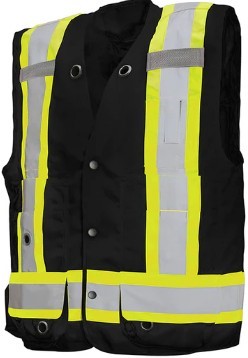
Features:
- Made of 100% durable polyester fabric
- 4″ contrasting colour tape with 2″ reflective silver tape on front, back and waist provides increased visibility
- Snap front closure
- Heavy-duty brass snaps and grommets
- Mesh side vents for breathability
- Dual straps for clip-on radio or ID badges
- D-ring access slot on the rear of vest
- 13 exterior pockets
- 4 interior pockets
3. Helly Hansen Workwear Women’s Alta Hi-Vis Shell Jacket
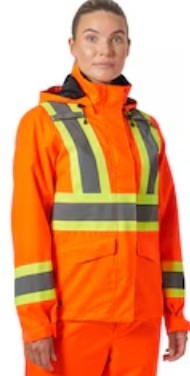
Features:
- Patented Helly Tech performance – constructed with breathable, waterproof fabric
- Attached hood with drawcord and fastener
- Brushed fleece inside collar
- Side-front pockets
- Napoleon pocket with YKK zipper
- Meets CSA Z96-22 class 2, level 2
- Fully taped construction
4. Tough Duck Men’s Hi-Vis Cargo Pants (Orange)
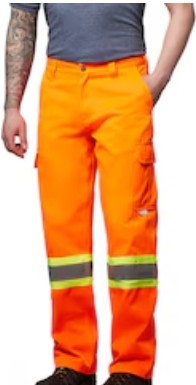
Features:
- Made in high-visibility orange fabric with reflective striping
- Waistband with 7 loops
- Side front pockets
- Back pockets with buttoned tabs
- Cargo pockets
- Compliant with Ontario Mining Association requirements
- CSA/ANSI* compliant when matched with Class 2 top with armbands
- Reflective striping made with 3M Scotchlite reflective material with 4" contrast backing
5. Dakota WorkPro Series Men’s T Max Hi-Vis Freezer Jacket
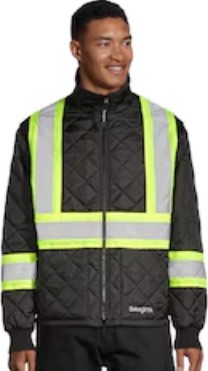
Features:
- Patented T-Max Insulation for superior warmth and maximum comfort
- Rugged 67g polyester taffeta shell fabric
- Body and collar lined with 300g polyester microfleece
- Sleeves lined with polyester for comfort
- Full-zip closure
- Mock neck
- Diamond-shaped quilting
- Rib-knit action back for mobility and comfort
- Large front patch pockets
- Interior vertical zippered pocket and hook-and-loop-closed pocket
- Ribbed cuffs to protect against the elements
- Fully compliant with CSA Z96:22 Class 1, Level 2 and ANSI/ISEA 107-2020 Type 0, Class 1
Understanding high visibility clothing
What is high visibility safety clothing or apparel? Also known as hi-vis clothing, these are clothes or clothing accessories that workers wear to increase their visibility in the workplace. Generally, high visibility clothing is used by workers to alert those who are driving trucks or operating heavy equipment, of their presence.
Wearing hi-vis clothing is critical in worksites that are dark or have poor visibility. Because they offer a form of protection against injury, these are considered a form of personal protective equipment or PPE.
When procuring hi-vis clothing, remember to include all the other important PPE for your staff as well.
High-visibility headwear can also be part of your workforce’s hi-vis kit. Wearing a brightly coloured hardhat can increase worker visibility that may be obscured by leaves, trees, traffic barriers, or other obstacles.
What are the standards or laws that govern hi-vis clothing?
The CSA Z96-15 (R2020) govern the safety ratings and serve as basis for hi-visibility clothing’s effectiveness in Canada.
Meanwhile, Canada Occupational Health and Safety Regulations (COHSR), specifically Section 12.17 of the Canada Labour Code requires employers to provide HVSA. This is mandatory if there is a threat of injury in the workplace due to moving vehicles.
Although the Labour Code generally requires HVSA to be compliant with CSA Z96, this can vary slightly when it comes to local regulations. Some of the variations in the law on HVSA in different provinces are:
Alberta
While the provincial regulations here do not mandate CSA Z96 compliance, Alberta's Occupational Health and Safety Code defines HVSA requirements for specific workers. The province makes special HVSA provisions for those engaged in the forestry industry.
British Columbia
WorkSafeBC requires strict compliance to HVSA requirements and cites CSA Z96 as their basis for compliance. WorkSafeBC likewise requires workers exposed to moving vehicles to wear the appropriate high visibility clothing.
Manitoba and Québec
Both provinces similarly mandate strict compliance with CSA Z96 standards. Worksites with moving vehicle hazards are required to supply staff with HVSA. Québec also emphasizes the use of reflective elements for underground work.
Ontario
Ontario’s high visibility clothing requirements are more detailed. The province requires workers close to vehicular traffic to wear fluorescent orange garments. These bright garments must also have specific retroreflective features.
Yukon, Northwest Territories, and Nunavut
These territories mandate workers that are close to vehicle hazards to wear HVSA that have both reflective and fluorescent materials. Their kits must be CSA Z96-compliant.
How to choose the right HVSA
When it comes to selecting the right HVSA for your workforce, it’s not always as simple as choosing from high visibility clothing class 1, 2, or 3. When choosing the right safety garments, these are the steps you can follow:
Step 1. Check your local safety regulations and legislation
Before selecting the HVSA, check your local jurisdiction's regulations on the requirements for hi-vis safety apparel. The last thing you want is to find out later that these PPEs are not CSA-compliant.
Step 2. Do a risk assessment of your worksite
Conduct a comprehensive hazard assessment. This is necessary to determine all the known and potential worksite hazards. This information will guide you in choosing the appropriate class of clothing. This assessment includes:
-
type and nature of the work – understanding the specific tasks workers must perform can help pinpoint potential hazards
-
worker and equipment interaction – knowing whether workers will work close to mobile equipment or traffic
-
degree and time of visibility – consider how complex the worksite will be and the lighting conditions. Will your staff be working in low light or darkness and for how long?
-
current controls – are there administrative controls, such as rules for working only in the daytime, or engineering controls like protective barriers?
-
work environment – is the worksite one with heavy vehicular traffic? Are the paths of vehicles simple or complex? Do your staff have to work in an urban, rural, or highway setting? Is the site clear of obstructions or cluttered with equipment?
-
warning distances and times - is there a high or low volume of vehicles? Are they heavy trucks, pieces of heavy equipment or small vehicles? Are the roads slippery, smooth, or rough?
-
distractions – is there any noise or visual clutter that can draw workers’ attention from hazards?
These are a small sample of the many hazards or risks that can be present in a worksite and necessitate the use of hi-vis apparel. You can use this guide to make a more detailed risk assessment. Remember to coordinate with your safety officer when assessing your workplace risks, if you have one.
Step 3. Choose the right class of HVSA with the appropriate material
There are different classes of HVSA made from different materials that meet the varying levels of risk. Based on your risk assessment, choose the class of high-visibility clothing that matches your worksite’s risks. More on this later.
Step 4. Check the different high-visibility material
To ensure that you choose the right HVSAs, make sure these standard materials are used in the construction of high visibility clothing:
-
Fluorescent materials – These materials enhance visibility in daylight and low light conditions but are ineffective at night.
-
Retroreflective materials – These materials are often used to make the reflective striping, so the material reflects light back to its source. Garments with retroreflective material are visible to vehicles or people who use lights in low-light conditions or even at night.
Step 5. Check the fit, comfort, and coverage
If you can obtain a sample of the HVSA, have one of your staff try them on. Make sure the clothing is snug, but comfortable enough to use during the worker’s entire shift. A proper fit should enhance visibility while allowing for additional layers if necessary – such as when outfitting for cold weather.
Ideally, the high-vis clothing should also provide full 360-degree coverage and have reflective stripes or bands that stand out from the garment’s background material.
Step 6. Verify its compliance with safety standards
Make sure that the HVSA you’re purchasing complies with the CSA Z96 safety standards. Usually, the garment will have a tag or label confirming that it meets the standards.
What are the classes of HVSA?
When choosing from the different classes of high-visibility clothing, matching its class to your workers’ needs is critical. Below are the different classes of safety and the level of risk they can handle. Note that they are mainly classified according to their level of risk.
1. Low Risk: Class 2, Class 1 under certain conditions
This class of high vis apparel fits workplace environments and situations where:
- vehicles run at speeds no more than 25 mph or 40 kph
- workers perform tasks that do not impede their awareness of approaching traffic
- there is enough space between workers on foot and traffic or other mobile equipment
- work backgrounds are not complex, allowing for optimal visibility
- workers are doing tasks that may occasionally divert their attention from approaching traffic
Some examples of low-risk category jobs include:
- directing vehicle operators to parking or service locations
- retrieving shopping carts in parking areas
- warehouse operations
- maintenance work on sidewalks or portions of the road
- receiving operations in shipping ports
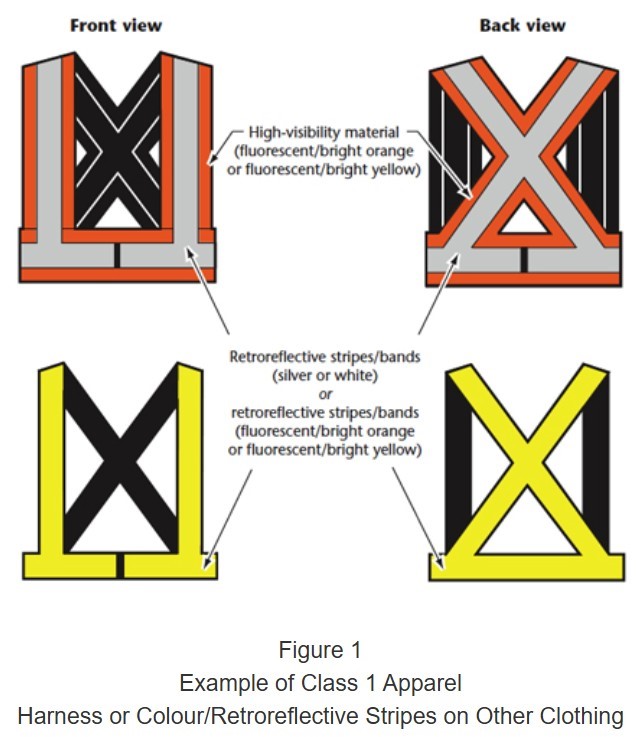
Source: CCOHS
2. Medium Risk: Class 2 or Class 3 based on certain conditions
Jobs or work environments that fall under the medium risk category include:
- vehicles or equipment are moving between 40 and 80 kph (25 and 50 mph)
- workers require greater visibility under harsh weather conditions or low lighting
- work backgrounds are cluttered and complex
- workers are doing tasks that take attention away from incoming vehicular traffic
- work activities are in closer proximity to vehicles, such as in, or near flowing vehicle traffic
Examples of medium-risk jobs that require this class of HVSA include:
- workers doing road construction
- workers at manufacturing plants or mills
- school crossing guards assisting pedestrians
- parking and toll gate workers
- airport baggage handlers
- ground crews doing aircraft maintenance
- emergency response personnel at the scene of an accident or calamity
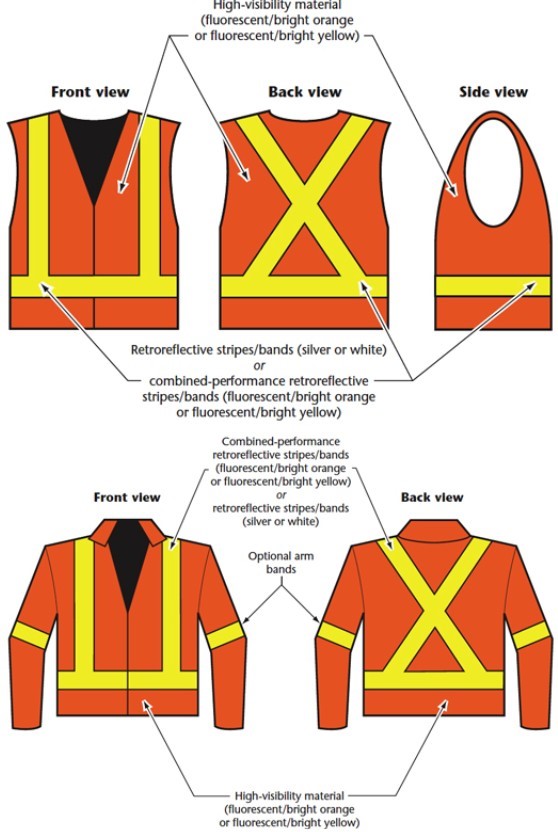
3. High Risk: Class 2 for daytime, Class 3 for low-light conditions
For this class, situations or working conditions include:
- vehicles that travel at speeds of or exceeding 80 kph (50 mph)
- workers on foot and vehicle operators have high task loads that may place workers in danger
- the wearer of the high-vis apparel must be visible through the full range of body motions at a minimum distance of 390 m (1,280 ft)
- Work activities take place in low light or at nighttime
Examples of high-risk jobs requiring this class of hi-vis apparel include:
- roadway construction workers
- utility workers
- survey crews
- mine workers
- emergency responders
- road assistance or courtesy patrols
- flagging crews
- towing operators
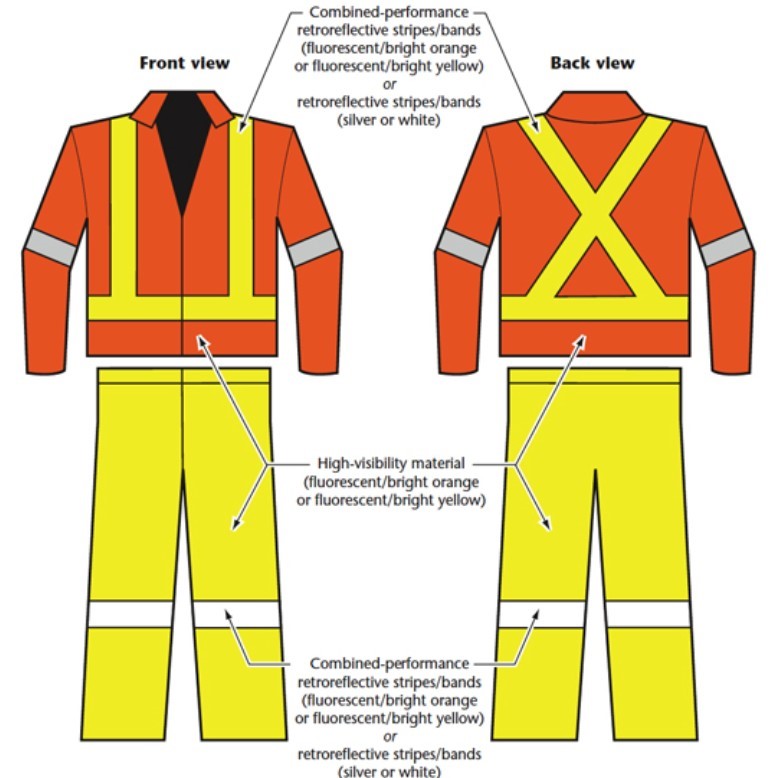
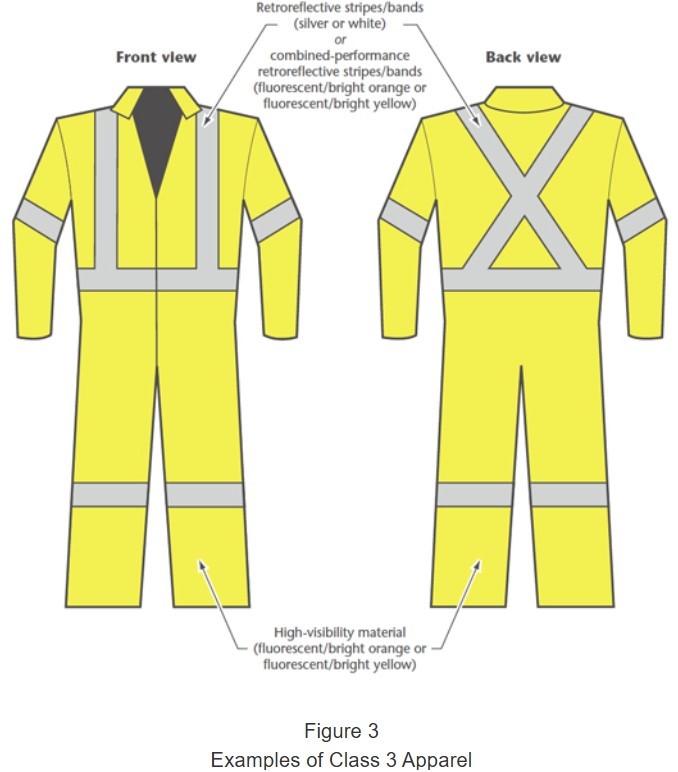
Note that the above illustrations are only some of the examples of HVSA and are not the only options available.
Benefits of having compliant HVSA
Procuring the right high-visibility clothing that meets the CSA Z96 standards gives the following benefits:
1. Reduced workplace accidents
Hi-vis apparel can significantly cut down the risk of accidents, since workers are clearly visible even in low-light conditions.
2. Avoiding penalties
Apart from avoiding accidents, your company can also avoid potentially hefty penalties by wearing the right HVSA. By having these PPE supplied to workers, you are legally compliant with federal and state regulations. Remember that by not supplying the necessary PPE like hi-vis garments, your company can be fined and penalized for violating workplace safety regulations.
3. Increased safety in emergency situations
Workers wearing hi-vis safety garments in an emergency can be quickly identified and located by first responders. Should there be an accident or calamity, hi-vis garments can reduce the response time and ensure that workers get the help they need as quickly as possible.
4. Improved workplace safety and morale
A safe worksite can translate to a happier workforce, knowing that they’re supplied with the necessary safety equipment because the company cares for workers’ safety and well-being. Note that the opposite can happen, especially if a CEO bans HVSA at their worksite because they “hate bright colours”.
5. Creates a professional image
Wearing compliant safety garments is a good indication that your organization prioritizes safety and professionalism. This, in turn, can boost the company's overall industry reputation and make your workers appear professional in the public eye.
HVSA as part of safety culture
Providing your employees with the appropriate PPEs, like high-visibility clothing, can have far-reaching implications for your company. Apart from keeping your workers safe, keeping your company legally compliant, and maintaining workplace morale, there can be another major effect.
By ensuring that your workers are highly visible in the workplace, there are other invisible benefits that may not be immediately apparent. You may be unaware of it, but supplying these safety garments and training employees in their use can help establish and reinforce a strong safety culture.
Did you find this piece on high-visibility clothing informative? Let us know in the comments



